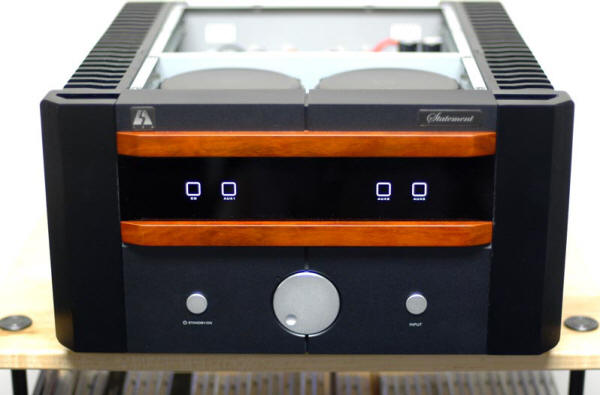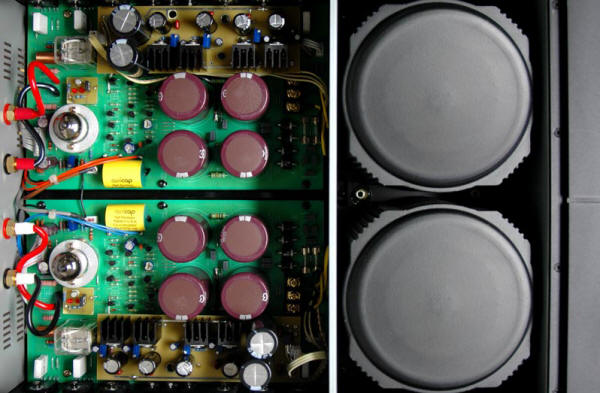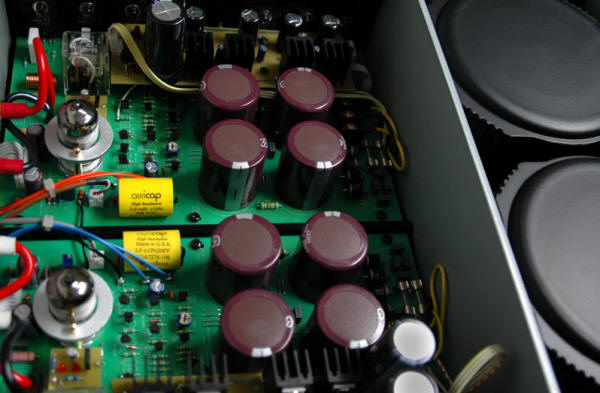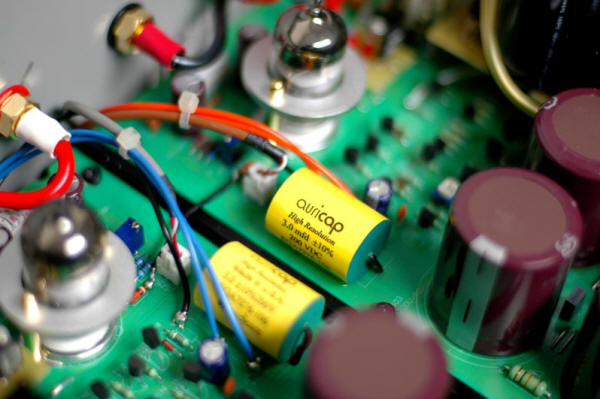You are reading the older HTML site
Positive Feedback ISSUE
january/february 2008

What
Price Beauty? The Good Doctor Introduces the LSA Statement Hybrid Integrated
Amplifier
by Dr.
Sardonicus

[Images courtesy of The LSA Group.]
A man should hear a little music, read a little poetry, and see a fine
picture every day of his life, in order that worldly cares may not
obliterate the sense of the beautiful which God has implanted in the human
soul.
~Johann Wolfgang von Goethe ~
Introduction
For some time now I have been increasingly of the opinion that a well-designed integrated amplifier is the most practical choice for a significant number of audiophiles, this for various reasons, not the least of which are: cost, space, issues with component compatibility, cabling, etc. I am even more convinced that most serious audiophiles need a good integrated to front secondary systems. For myself, I keep a Ming Da EL-34 AB around when I want that tube sound (switchable between triode and ultralinear), alternatively driving both primary and secondary systems. I am a big fan of flexibility and being able to easily affect a change of pace.
Admittedly, integrated units have not historically carried the necessary cachet to attract more well-heeled buyers (unless constrained by space), but over time this has slowly changed, with increasingly more sophisticated (and pricey) offerings from a wide variety of builders. Recently there are interesting developments in the opposite direction; the increasing availability of shockingly inexpensive Chinese-made units dominating the lower price rungs (where price is always a backdrop in evaluating the component).
I know that exclusivity is certainly a driver in audio, but it is comforting to me that younger and the more financially conservative buyers can build very satisfying systems without having to sell a kidney to do so.
As it stands now, virtually every taste and pocketbook are represented in available integrateds, from juicy exotic flea-watter SET units, more powerful push-pull tube units (of a bewildering array) to hybrids (such as the LSA Statement currently under consideration) and increasing numbers of solid-state units (of various topologies) in the three-and even four digit power output range.
The fact remains, even with the participation of some of the most recognizable names in audio (BAT, Krell, Jeff Rowland, Audio Note, at al) there remains, I think, a slight uneasiness that if you combine two components into one box there are inevitable compromises that have to be made; that integrated units, (whatever their pedigree) are "lesser" creations than their separate (and therefore more prima facie refined) cousins.
Additionally, in the case of the LSA Statement we have a combination of three, rather than just two components. Not only have they combined the pre and power amplifier sections, but they have also added a phono preamplifier stage (appropriate for high output MC and most MM cartridges).
Also of interesting note, LSA does not produce separates …just three iterations of this one hybrid integrated amplifier: a basic model, called the Standard ($3200 ), an intermediate version (Signature, MSRP $6000 ), said to give the best "bang for the buck," and the full-out Statement ($9000).
I like this idea.
Maybe it is because of my advancing age (and the nostalgia which inevitably accompanies it), but in memory-shrouded reconstruction, I always appreciated the old Sears catalog differentiation of (Good, Better, and Best) range of choices for major items. Fact is, though, at $3200, the Standard is in a different market entirely from the $9000 Statement version.
The differences among the three machines are said to be in the quality of the parts and the addition of an "active tube load" circuit in the Signature and Statement models (described as a cathode follower system that regulates high-voltage current through the tubes, resulting in a higher impedance and bandwidth load, which in turn supposedly produces lower levels of tube distortion). The Statement also features somewhat different cosmetic trim, as well as even more parts upgrades from the Signature version.
The difference between the Standard and Statement level pricing was significant enough to cause me to pause, but as I discussed this issue with Jennifer Crock, PFO Senior Technical Editor, she assured me that between the raw costs of the parts themselves (a capacitor can range in cost from a few cents to a significant wad of folding money) and with the time and expertise to change them out …it is easy to see where the money goes.
LSA bought out DK Design Group three years ago, and currently offers updates of the three versions of the hybrid integrated amplifier, a CD player, and several speakers. While LSA describes the "upgrading" process for the amplifiers as taking place in Everett, Washington, the original point of origin for the manufacturing is in China.
Basic Description

The LSA Statement is a large, heavy and quite attractive unit (for all its squarish construction) with a simple, but heavy metal remote (on-off, volume, and input switching). From visuals to operation… everything is silky and maintains a consistent impression of quality and refinement. The basic color scheme is mostly matte black, with red trim.
I suspect most users will choose a floor stand for this behemoth, rather than trying to tuck it into a regular stand, but it is so well laden with heat-sinks that high temperature really isn't an issue (it has never gotten even warmish to the touch in my room)… it's just the weight and overall size that suggests floor placement.
In spite of the obvious fact this is a hulking integrated …it is a bit stealthy so its size is not so visually dominating (say if it had been done up in a more flashy way, like bright metal casing). While I liked the clean styling, again, I wish that practical considerations (ala LAMM) were balanced with prettiness.
Ahem! Anything that weighs seventy pounds should have handles.
Packing was well thought-out and effective, but not over-kill. The unit requires two people for safe placement, and although it bristles with heat sinking, they are not sharp-edged (as was apparently the case with earlier versions). Documentation is a bit less than desirable, but the basics are there. I got briefly confused, because the documentation is the same for all three pieces.
I used the RCA inputs and hooked up a proprietary Jena Labs splitter on the pre-out to feed the HSU sub and mid-bass arrays. Sadly, my Cardas Heart MC is insufficiently robust to drive the phono stage, so it is not addressed in this review.
The "hybrid" part of the design is a brace of EH 6922's in the preamp section. This gave me initial pause. Jennifer Crock maintains the 6922's were never intended to be audio tubes—not that this prevents designers from using a host of other such tubes. The solid-state power section is MOSFET with huge toroidal power supplies.
I have to admit my initial interest in the Statement was driven by coming across their website and thinking how interesting the piece looked and then finding out it was a $9000 integrated amplifier, and sourced relatively close by in Washington state.
Oh, to be sure, this is far from the most expensive such animal out there, by any means, but pricey, nonetheless.
I was intrigued.
With the LSA Statement, you will use up the lion's portion of ten-grand, and most people are going go to separates at this price point, unless there is some compelling reason for them to do otherwise.
However it may be lamented and denied, audiophiles are a strangely conservative lot when it involves remaining within the fashion pack (probably driven by re-sale concerns …isn't that an irony?).
I think people will actually buy things they aren't really that thrilled with, so long as they believe that someone credible suggests it, and they think they can turn the piece easily when the inevitable restlessness sets in, or when the piece is no longer au courant.
Once again, the myths we learned persist through time, even when their foundations have crumbled away.
So, Doc …how does it sound?

The primary question to be answered here is, why in the world would someone buy a $9000 integrated amplifier when there are so many fine separates at or near this price point?
Asked in another way: when the gloves come off (which they absolutely do at this price level), can the "compromised" integrated compete on flat ground with separates?
Short answer? I could easily live with the Statement and never feel I was giving up anything of essential importance. Recognizing that I would be giving up a couple of things in terms of number of inputs/outputs and the like, I can and did work around these without much bother. Once set up, these things became insignificant.
How the piece performed, musically, in comparison with my much more expensive BAT separates (VK-51 SE and VK-600 SE) ultimately comes down to a matter of taste, with the BAT falling to the side of superior neutrality (but still imminently musical), extension and detail, and the Statement providing this ineffable, loving "prettiness" I found enduringly seductive.
I am not the only one enamored of this piece …I was made aware that Winston Ma of FIM music uses a pair (in amplifier only mode) in his cost-no-object listening room, driving humungous Avalon Sentinels.
But, to be sure, this is NOT the piece for you hair-shirted audiophiles who aren't having fun unless you are in pain, and restricted to only a few recordings you can actually listen to, or for those of you who are hooked on the endless upgrade and change-out Gerbil wheel. The slightly forgiving nature of the Statement will be a distinct advantage of those who struggle with older recordings or digital in general.
This is an amplifier for grownups.
When you know who you are and what you like, and are unmoved by the shallow swings of shifting fashion …when you are ready to settle down and commit to a long-term relationship …when music is the objective, not the equipment …then this is one piece you absolutely have to hear.
In combination with the luminously musical Marantz SA-7S1, this baby will beauty you into submission. As with the Marantz, it is neither overly sweet nor aggressively forward. More like a perfect Spätlese, it is perfectly balanced and nuanced to provide both compelling complexity and squirmy pleasure. It's beautiful. A flinty dry Chardonnay it is not.
The forgiving nature of the Statement does mean it can be a bit restricted in terms of ultimate top-end air and resolution in direct comparison with the significantly more expensive BAT VK-51 SE/VK-600 SE combination (which is truly world class in this regard, as I am reminded of each time I return to it after a brief dalliance with other equipment). I really do not see this as a failing in the Statement, but because there is no sizzle, I can see why the traditional audiophile might think something is missing. The top end is liquid without lift or tizz, and in the context of current "hi-fi" this is often perceived as unduly rolled-off.
The sharp differential in power between the Statement (@150 watts) and my reference BAT VK-600 (@300 watts) per channel never intruded into consciousness, until I switched back to the BAT and recaptured that "floaty" hugeness that only gobs of power and endless current storage can give you.
Over the past few months I have pushed this amplifier hard with a wide variety of full orchestral and rock material, and never heard the slightest strain. Both micro (inner) and macro (large scale) dynamics were convincing.
The LSA Statement is such a good match with the Marantz that I have actually struggled to separate the two as I listen. When I have changed either amplification or source, the results ended up being very similar as to what changed in the overall presentation; cut from the same cloth these two are.
The SA-7 and the Statement are magical together. Although the essential character of both maintains through other combinations, this one combination is just particularly felicitous. At a hair over fifteen grand for the both, I seriously doubt you can do better anywhere near this price.
I can see the canny music lover pairing these two pieces up with an appropriate set of speakers (and necessary ancillaries) and living quite happily ever after, while his or her neurotic counterpart trudges relentlessly down to yet another dealer every few months … vainly trying to dip deeper water from similar wells.
Admittedly, at times I wondered if everything wasn't just a bit too pleasing, too pretty …but hearing the same material on other components and systems quickly assured me that sometimes beauty is not always skin deep, but ugly very often goes right to the bone.
All I had to do to re-establish balance, was to put on NIN, or Ministry or any of a hundred different un-pretty offerings and hear the growl and howl, quite preserved but never shrilled.
Fully ran in, and properly lashed up and optimized, the Statement/Marantz combination gives you the slam and dynamics needed for full orchestral and heavy rock material. Just as adroitly, you get the pure aching, lit-from-behind delicate tonality supposedly reserved only for low power SE amplifiers.
The proverbial best of both worlds.
For me, this combination was a flame to my "moth-ness" inexorably drawing me back, over and over again to much more frequent and much longer listening sessions than I could reasonably afford (time-wise); too many bleary-eyed mornings due to unplanned late-night listening sessions. I blame both components equally (but not, of course, my own complete lack of self-control).
What is missing from the Statement is any hint of an "electronic" nature; no glare, no grain, no MOSFET "mist," no euphonic colorations …no compression or limitations for anything approaching a reasonable load.

Conclusion
Within the first week I knew the Statement was a sure thing for my writer's awards for 2008 and that I will probably only give it up after a stern admonition to do so by LSA.
I fully understand there will be those whose interest will evaporate upon discovering its country of origin, and also those who will evoke the Red Rose/Dussun scenario. There is nothing that will satisfy you, if that is where you go first. You won't bother to keep an open mind and listen for yourself, and it will be your loss.
As to my concerns about saying goodbye too soon …after all, this really is only a preview and it will take considerable time to really plumb the depths of this piece …yeah, that's the ticket!
No, that is not true.
The reality is that I have plumbed its depths and found the LSA Statement to be truly meritorious and worthy of my strongest endorsement. This is an enormously musical piece and if you seek beauty and strength, I am hard put to suggest where you could do better at anywhere near this price point.
Bravo!
Post Script:
It really wouldn't be one of my pieces if I didn't go on a rant somewhere within its boundaries, now would it?
Reading a recent ineffably silly article focusing on the arbitrarily assigned difference of 5% between pedestrian and "high end" equipment, and being persistently annoyed by it …I might offer this frame. There is about a 5% genetic difference between apes and men …but that difference is the difference between throwing your own poo when you are annoyed …and Einstein, Shakespeare and Miss January.
If there is only a 5% performance difference between the Standard and Statement level LSA integrateds …it may still be well worth the difference in price.
The LSA
Group
6949
Charlotte Pike, #107
Nashville, TN 37209
1.888.671.8607
1.615.356.0180
email address:
[email protected]
web address:
www.thelsagroup.com
